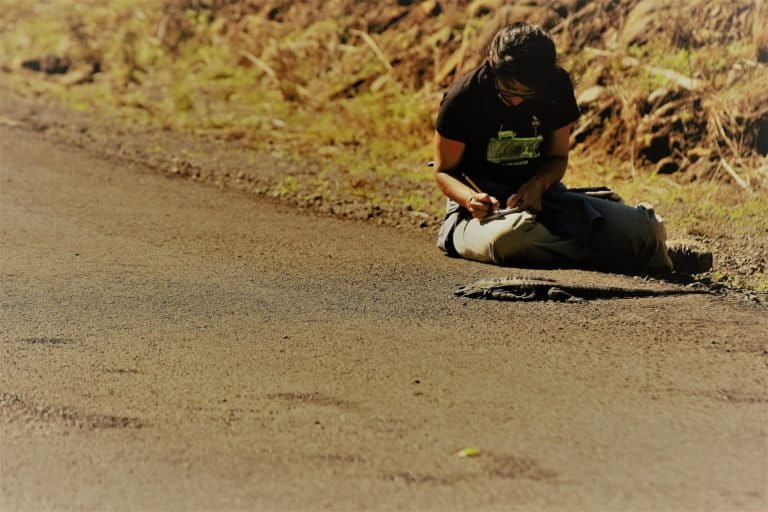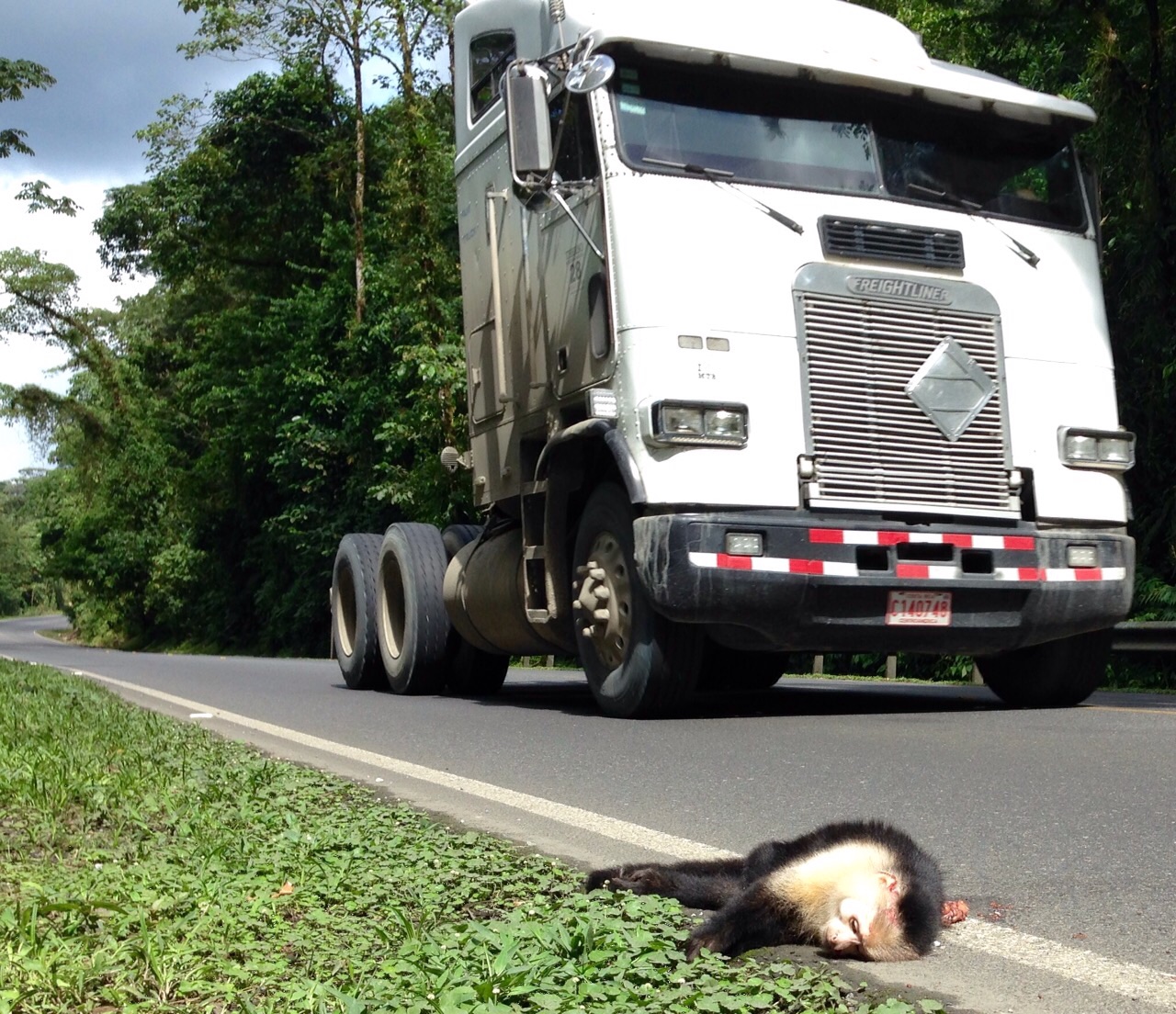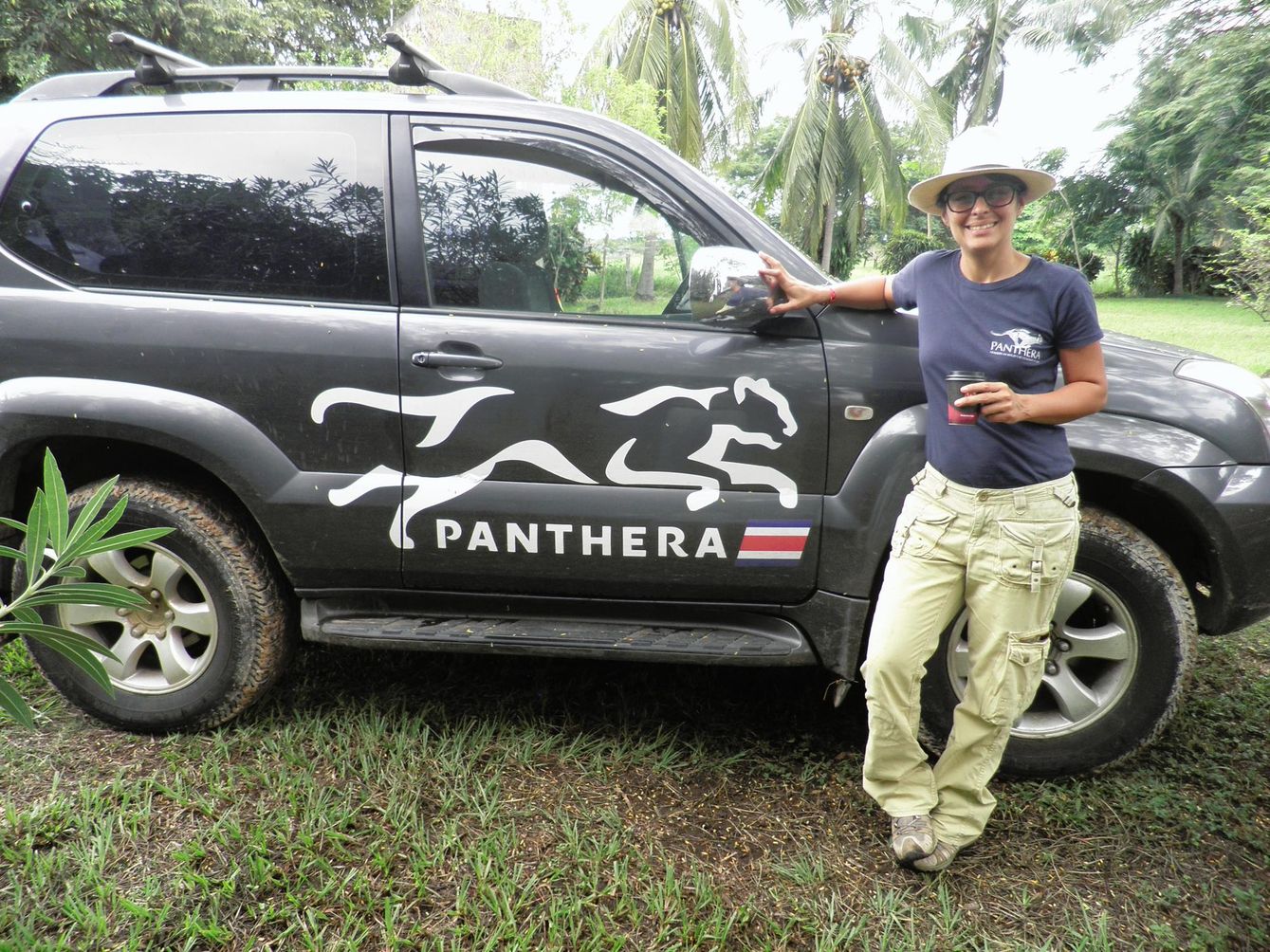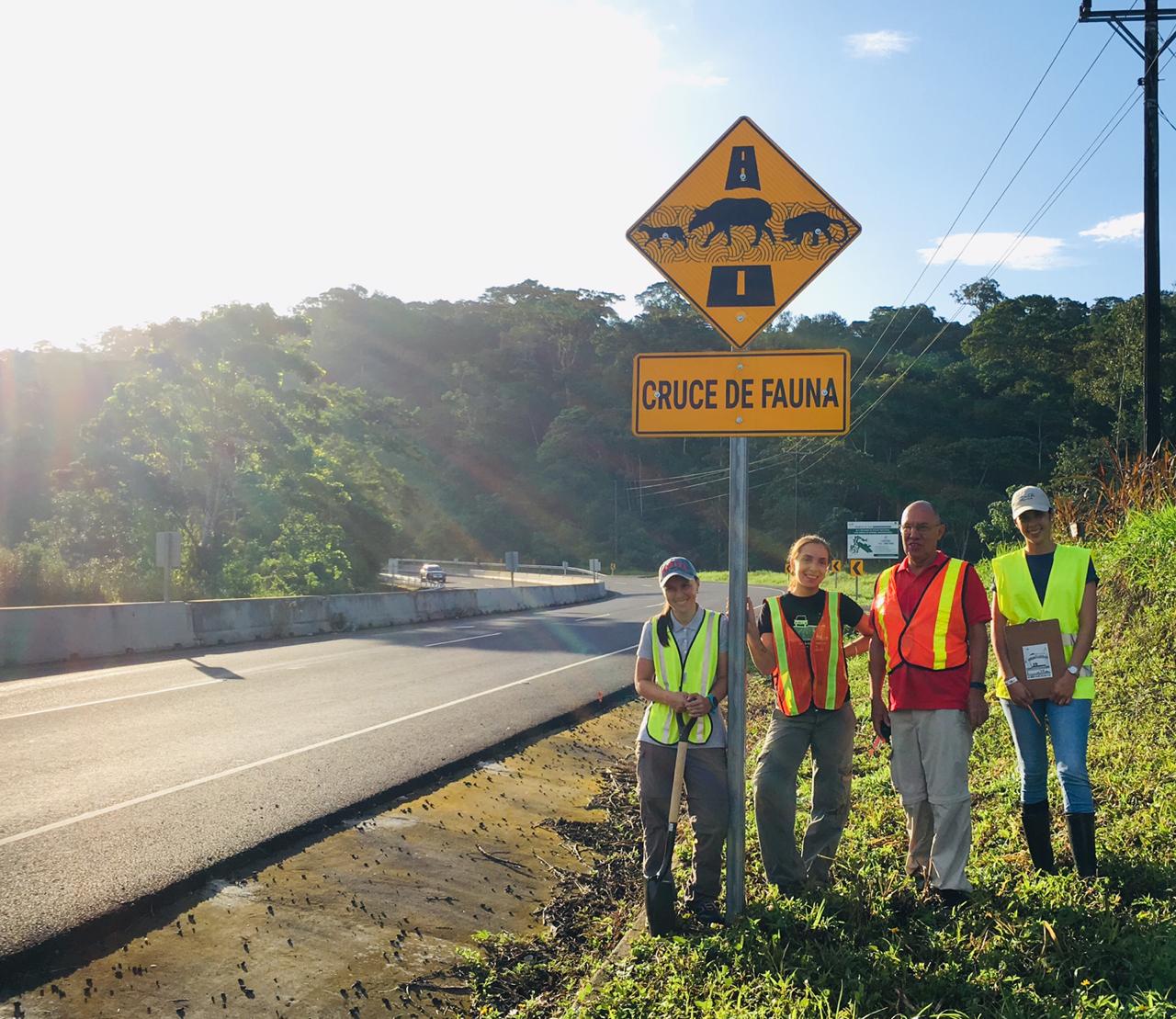- In Costa Rica, biologist Daniela Araya Gamboa is working to protect wild cats from becoming victims of the highways.
- In 10 years of working, she has registered the highway deaths of almost 500 cats of six different species.
- Her team provides decision-makers with concrete evidence so they can find solutions.
The nature of her father’s work, as an aerial fumigation pilot, meant that Daniela Araya lived in many areas of Costa Rica when she was a child. She usually traveled with him in rural areas on roads with slow speed limits. On these journeys, whether at dawn or at night, they admired the numbers of animals that crossed their path and continued naturally on their way. On occasion, they helped the animals to cross.
“This was exciting for us: to go on rural roads, where no one drove fast, rescuing the animals on the road. With time, it became more frequent to find them not alive, but run over,” says Araya, now a biologist. “It was frustrating to see so many dead animals on the road — and this is how I started to look for ways to make an impact, but now focusing on cats,” she says.

Daniela Araya Gamboa is the coordinator of the Caminos Amigables con los Felinos (Cat-Friendly Roads) project, from Panthera Costa Rica, where she has worked for 10 years. Her daily routine consists of pulling on her rubber boots, putting on a reflective jacket, getting in a car at dawn with sirens and lights and driving along dangerous roads, which are risky not only because of fast-moving vehicles, but also because organized criminals sometimes guard them. On these roads, Araya and her colleagues count animals that have been run over.
Mongabay spoke with the wild cat expert who knows the risks that these species face on Costa Rica’s highways, where the organization registered 491 individual animals run over between 2012 and September 2022.

Mongabay: At what moment did you realize that the roads posed a serious problem for the cats? Why do we need to think about roads in regard to wildlife?
Daniela Araya Gamboa: This project started when we were working on a biological corridor focused on jaguars. This is an area that lets the jaguar go safely from one protected area to the other, and we realized that they were going to pave a route. It was an opportunity to record data before and after it was paved. This was our first project on a highway, and we opened a sort of Pandora’s box: We discovered that the female jaguars stay away from the highways, and the males sometimes cross them but also avoid them. The Guanacaste area, in Costa Rica, started to develop as a tourist attraction, and it is an area of high density of jaguar populations, so with the increase in traffic flow, the number of accidents also increased.

Mongabay: How is your workday before and on arrival at the road?
Daniela Araya Gamboa: The part before is the most boring; just office work and preparing reports. I prefer fieldwork. My job is sad, but as time goes on, your heart gets harder, you get over the pain and you focus on the fact that recording this data is valuable to provide evidence of the impact. When we do fieldwork, we get up very early; we have to be on site at 5:30 in the morning. We go along the selected route by car, which until now have gone between 2 and 45 kilometers (1 to 28 miles), and we go at a maximum speed of 30 km per hour (19 mi per hour), counting the run-over animals along the way.

We get out and run to the animals [at the side of the road] because the next day or the same night, we’ll do it all again, so we want to make sure we’re not duplicating data. We record the incident, marking the spot with GPS and taking a photo. We repeat this for around six months, to obtain a sample representative of the site: which animals are killed by cars, and which we see alive. We also install hidden cameras in the area, and with those we can see which animals are at the side of the road. We install them both on the forest floor and in the trees because we also need to know which animals live in the canopy. We also place cameras on animal crossings, which are both low down and higher up for tree-dwelling species, so we can see which species are crossing safely. The issue of crossings [for animals] is starting to be discussed in Latin America, so all of this information will help us improve and adjust our methods to minimize the impact of roads. For example, there are passageways in the air for tropical species, and these should stay as they are. Other countries already have experience in this, principally in Europe and North America, but we have to keep adapting the measures for Latin America.

A Panamanian white-faced capuchin (Cebus imitator) using an aerial crossing for tropical species. Video courtesy of Panthera/MOPT.
Mongabay: What are the most recent research findings about the deaths of cats on highways?
Daniela Araya Gamboa: There have been a total of almost 500 wild cats run over in Costa Rica in 10 years. This list includes the six species: jaguars [Panthera onca], pumas [Puma concolor], jaguarundis [Puma yagouaroundi], ocelots [Leopardus pardalis], margays [Leopardus wiedii] and oncillas [Leopardus tigrinus]. There are six species of cats in Costa Rica and all six have been run over. The oncilla is the smallest species and, according to the data collected, we have found that it is the most threatened. It only lives at high altitudes in cold and mountainous places, and we have reports of accidents, for example, on a highway in a protected area there were up to three accidents in one year with this species. This has a huge impact on biodiversity conservation. The species that is killed the most is the ocelot: In one year, there were 51 ocelots run over on the highways of Costa Rica, in 2021. To put this into perspective, the ocelot population in the United States is around 50 individuals. It’s insane, for this tiny country, to have this huge loss of biodiversity.

Mongabay: Apart from impacts on cats, how else do roads impact biodiversity?
Daniela Araya Gamboa: We have found that the highways don’t just impact cats, but whole ecosystems. This is even more serious because, for example, with hunting you lose wild pigs and deer, but the highways are hunters that don’t specifically target one species but take everything in their path — bumblebees, crabs, insects, snakes, frogs, tapirs. They take everything. They’re having a gigantic impact. They aren’t like hunters who sometimes go to the forest. The highways are hunters that work day and night, around the whole country, near protected areas and reserves. They don’t take days off.
It’s a big impact that we have to keep studying, and that’s our main contribution: to keep determining this impact and collecting all of the information so that citizens, governments and decision-makers have more accurate information. When we take people to work with us they say, “You’ve changed my life, and you’ve made it more difficult because before, I didn’t notice when driving which animals had been run over. After going with you and understanding what’s happening, I now see things like sloths, anteaters, opossums.” People travel quickly, and we don’t truly notice things. Before, life wasn’t so accelerated, but if you drive slowly near a protected area, you’ll start seeing frogs, snakes, insects, mammals and birds. There’s a route where, in just one day, we counted up to 25 birds run over in only 40 km (25 mi), in protected areas where it’s not just common birds that die, but hummingbirds and other important bird species for conservation.

Mongabay: So do society, governments and decision-makers not give enough attention to the threat of highways for wildlife?
Daniela Araya Gamboa: Highways are valued for a country’s development. They are seen as a bridge to development, as access to Indigenous peoples, and this has allowed us to skip over their impact on wildlife. But when the number of roads starts to increase, the cost is that people continue to think that animal mortality is normal. Dead animals in the road are part of the landscape. We’ve normalized it, and we’re used to seeing two or three dead animals on a journey. But when a researcher comes and monitors it in detail, with many repetitions, that’s when we realize that it’s a serious issue.
That’s where we come in. There are three of us biologists in our group, which is called Wildlife-Friendly Roads (VAVS by its Spanish initials) — I work with Esther Pomareda from Las Pumas Rescue Center and Sanctuary and Esmeralda Arévalos from the Latin University of Costa Rica. This year is our 10th anniversary of working together on this issue in Costa Rica. We came together with the same dream: to contribute, guide and recommend all of these actions to the government to reduce impact. Together with other researchers, we created the “Wildlife-Friendly Roads” environmental guide for Costa Rica, which the ministry of transport uses for all their new road development projects and for highway expansion or construction. The intention is that they can use this data to build wildlife crossings.

But it’s not just us; there are many other researchers in various countries in Latin America that are trying to provide decision-makers with concrete evidence. For example: In 45 kilometers of a highway adjacent to protected areas and national parks, there are 4,000 wild animals killed in a year, including birds, mammals and various other groups. And what can we do about it? Well, let’s not get ourselves down about it — we are constructive, proactive, and we work together with the road administrators to search for ways to reduce this impact. This is where wildlife crossings come in — making them specific for the wildlife that live in each place, and building them where the most animals die and where there is a higher probability of them crossing the road.
What work has the Panthera organization done in this area? How have you been collaborating with the government?
Daniela Araya Gamboa: We do the science and support conservation efforts, that’s our focus. In simple terms, we go to the field, collect data and present it to the government so that they can create ways to reduce this impact. It’s a slow process, because we’re all still learning. We have to keep adapting the conservation protocols to the roads and to the crossings. We have to celebrate every win, big or small. And at the same time, we have to keep looking out for ways to deal with these issues on a national level.

Mongabay: All this information is given to decision-makers, but how can we transfer this information to society, which also has to take responsibility on the roads?
Daniela Araya Gamboa: This is a very important issue. We have a Facebook page where we receive all the accident reports on a national level, focused mostly on cats, and this has raised awareness and allows us to collect citizen science, data from the public. We have also worked on a page called Wild Costa Rica (Costa Rica Silvestre), specifically for the public, where we provide guidelines on the impact and how to tackle it. Until recently, if someone found a dead animal on the road, they wouldn’t have clear guidelines on what to do. So we explain what to do, prioritizing the safety of the driver and passengers of the vehicle, and who to call to report it.
There’s also an app, iNaturalist, where people can report accidents nationwide; one can take a photo, submit the coordinates, and this contributes to national knowledge. We also recommend considering your speed around forests or protected areas and keeping in mind not only the safety of wildlife, but also of the driver. Vehicles have been completely written off on highways in Costa Rica, such as in motorbike accidents by collision with ocelots or tapirs.

Mongabay: After monitoring impacts, what happens to the animal corpses found on the roads?
Daniela Araya Gamboa: At Panthera we have a genetics project, which works in two ways, focused on cats. By collecting genetic samples, what we want to know is whether the populations are connected or isolated. How do we collect this genetic material? We have a trained dog who finds cat feces in the forest; this dog travels across the whole country to specific forests and detects these collected feces. The DNA is extracted from the feces because it contains the intestinal cells of the animal. The other way we collect samples is when we find a dead wild cat. We collect a tissue sample so that the information can contribute to this genetic study at a national level.

Mongabay: Working with animals in this situation must have a strong emotional impact. How do you stop your emotions from holding you back?
Daniela Araya Gamboa: Counting wild animals that have been run over is very hard, and it stays with you forever. For me, it affects me the most when the wild animal is still alive. That’s when I lose all capacity and break down. Counting animals that have already died is … well, my heart has hardened to it and I get over it. But arriving on site, monitoring and finding an animal that is still alive is very hard. Firstly, because it’s very difficult to give the animals emergency medical attention, and a lot of times, the hit is very difficult to survive. Most animals that arrive at our rescue center wounded from an accident die. And among those that survive, a very low percentage are able to return to the forest.
It’s an issue that we’ve really been trying to work on because if we burn out emotionally, we lose people who have been working for a long time. We can’t lose the knowledge that we’ve acquired. What we can do is transform the sadness into action. I counted 60 knocked over animals today, but tomorrow I’m going to review the photos of the wildlife crossing and I’m going to see the otters crossing, I’ll see the raccoons, the greater grisons (Galictis vittata), the ocelot crossing safely under the road.

Mongabay: What message do you want to leave with your work?
Daniela Araya Gamboa: We live on a ship called Planet Earth and we can’t get off it. There is no Plan B. We have to really look after this ship, because it’s losing parts every day: It’s losing amphibians, reptiles, mammals. The loss of biodiversity is a heavy subject and part of this is the issue of highways, which is one of the biggest flaws on our planet. We must address the expansion of road networks without regard to wildlife — we can’t keep putting it off and turning a blind eye. Thousands of wild animals die every day on the highways of Latin America. This ship is heating up, and by losing all its components, repairing it is going to be more and more difficult.

Banner image: A jaguar crossing a road, taken in 2015, in Costa Rica. Image by: Helder Casanova/ICA.
This story was reported by Mongabay’s Latam team and first published here on our Latam site on Oct. 6, 2022.
